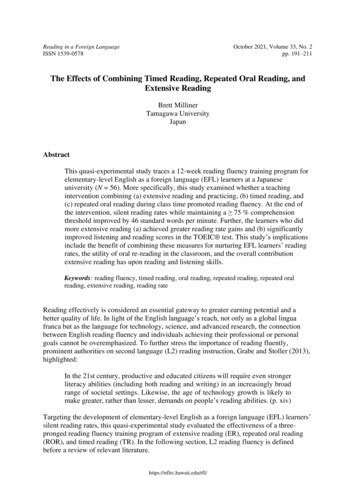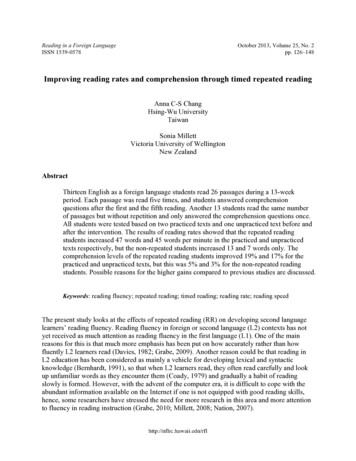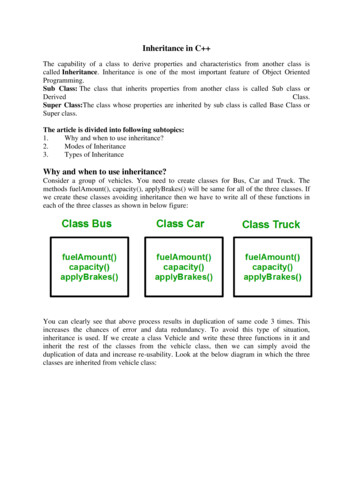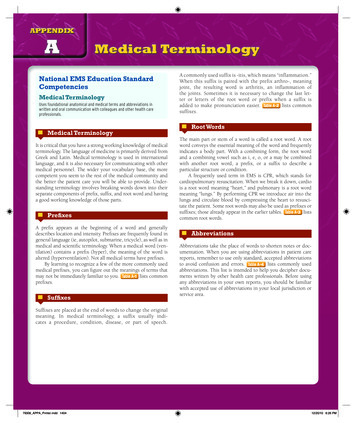
Transcription
Reading in a Foreign LanguageISSN 1539-0578October 2021, Volume 33, No. 2pp. 191–211The Effects of Combining Timed Reading, Repeated Oral Reading, andExtensive ReadingBrett MillinerTamagawa UniversityJapanAbstractThis quasi-experimental study traces a 12-week reading fluency training program forelementary-level English as a foreign language (EFL) learners at a Japaneseuniversity (N 56). More specifically, this study examined whether a teachingintervention combining (a) extensive reading and practicing, (b) timed reading, and(c) repeated oral reading during class time promoted reading fluency. At the end ofthe intervention, silent reading rates while maintaining a 75 % comprehensionthreshold improved by 46 standard words per minute. Further, the learners who didmore extensive reading (a) achieved greater reading rate gains and (b) significantlyimproved listening and reading scores in the TOEIC test. This study’s implicationsinclude the benefit of combining these measures for nurturing EFL learners’ readingrates, the utility of oral re-reading in the classroom, and the overall contributionextensive reading has upon reading and listening skills.Keywords: reading fluency, timed reading, oral reading, repeated reading, repeated oralreading, extensive reading, reading rateReading effectively is considered an essential gateway to greater earning potential and abetter quality of life. In light of the English language’s reach, not only as a global linguafranca but as the language for technology, science, and advanced research, the connectionbetween English reading fluency and individuals achieving their professional or personalgoals cannot be overemphasized. To further stress the importance of reading fluently,prominent authorities on second language (L2) reading instruction, Grabe and Stoller (2013),highlighted:In the 21st century, productive and educated citizens will require even strongerliteracy abilities (including both reading and writing) in an increasingly broadrange of societal settings. Likewise, the age of technology growth is likely tomake greater, rather than lesser, demands on people’s reading abilities. (p. xiv)Targeting the development of elementary-level English as a foreign language (EFL) learners’silent reading rates, this quasi-experimental study evaluated the effectiveness of a threepronged reading fluency training program of extensive reading (ER), repeated oral reading(ROR), and timed reading (TR). In the following section, L2 reading fluency is definedbefore a review of relevant literature.https://nflrc.hawaii.edu/rfl/
Milliner: The Effects of Combining Timed Reading, Repeated Oral Reading, and Extensive Reading192Literature ReviewReading fluencyFluency training in the L2 classroom allows learners to use the language they already knowand “make language knowledge become readily available for use” (Nation, 1991, p. 1). Twofundamental components of fluency are attention to speed and accuracy (comprehension).Interestingly, when talking about most macro-language skills (e.g., writing), speed increasesare often detrimental to accuracy. As for reading, however, there appears to be a somewhatinverse relationship (Grabe, 2010). Increased reading rate correlates with improvedcomprehension, and the reading experience starts to become enjoyable. Nation (2005)presented another helpful perspective on this relationship when he noted that reading speedsless than 100 words-per-minute (wpm) may handicap learners’ memory retention andconcentration. For these reasons, fluent reading in the L2 is a “key indicator of a highlyskilled reader” (Grabe, 2010, p. 73) and a skill that demands greater attention from foreignlanguage teachers.Reading fluency involves the rapid, smooth, accurate reading of connected text with littlefocus on the mechanics of reading (Goldfus, 2014). Developing a degree of automaticity,particularly in the deployment of lower-level reading processes (e.g., word recognition,syntactic parsing, and the formation of semantic propositions), is critical for reading fluencygrowth (Grabe & Stoller, 2013). Only after these lower-order processes are automatized can areader have enough mental space to engage the higher-order cognitive processes critical fortext compression (e.g., inferencing and attending to semantic cues). While there are severalvariables of interest when measuring reading fluency, this study focuses on reading rate; mostnotably, reading rate according to Carver’s “rauding theory” (1990, p. 5). Rauding concernsthe rate at which learners attend to each word in a text while understanding the completethoughts or themes presented in the sentences of text (Carver, 1990). Therefore, this studywas interested in the rate or speed at which EFL learners could read each word of a text whilemaintaining a respectable comprehension level.In the following sections, several approaches suggested for nurturing L2 learners’ readingfluency are presented alongside some of the research describing their efficacy. However, it isimportant to firstly describe the EFL learning context of this study–Japan, and the uniqueneeds that Japanese learners have in improving their reading fluency.What are some characteristics of Japanese readers of English?Although communicative language teaching and other contemporary approaches are filteringinto English classes in Japanese schools, reading is still primarily taught to support grammarand vocabulary building explanations. Upon finishing high school, most Japanese studentswould have only ever experienced intensive reading or reading as a word-by-word “textdecoding” exercise (Waring, 2014, p. 215). At the extreme level, the consequences of theseapproaches are perhaps best described by Takase (2003), who observed learners readingsentences backward to process the syntax more easily. Given these conditions, it is nosurprise that after 6 years of English education at school, Japanese university freshmenaveraged 79 wpm in Robb and Susser (1989), 77 wpm in McLean and Rouault (2017), and 82wpm in Taguchi et al. (2004). These reading rates are far below Nation and Macalister’s(2021, p. 72) suggested reading fluency benchmark of 250 wpm for English learners. PerhapsReading in a Foreign Language 33(2)
Milliner: The Effects of Combining Timed Reading, Repeated Oral Reading, and Extensive Reading193more concerningly, reading rates below 100 wpm are described as being torturous for L2learners (e.g., ERF, 2011; Nation, 2005).Classroom interventions targeting the development of EFL learners’ reading fluencyTimed reading & reading fluencyTimed Reading (TR) or speed reading targets the automization of word-level knowledgethrough consistent reading practice (Waring, 2014). TR programs have learners read shortpassages of similar length with lexis restricted to only the most frequently used Englishwords. The teacher’s role is to encourage learners to read faster while maintaining 70%accuracy on post-reading comprehension questions (Nation, 2014). It is also recommendedthat learners keep a log to track the progression of their reading rate.One of the most cited TR interventions is Chung and Nation’s (2006) study on the effects of a9–week course for 49 EFL learners at a Korean university. Participants read a total of 23passages in class and at home. By the end of the course, participants had increased theirreading rates by 52%, from 141 wpm to 214 wpm. To effectively measure wpm gains, theresearchers used three markers: (a) the average scoring method (subtracting the average scorefor the last three texts from the first three texts); (b) the 20th minus the 1st; and (c) theextreme scoring method (subtracting the fastest from the slowest wpm). While the readingrate gains were impressive, the authors did not report whether learners did any other readingtraining during the intervention.Tran (2012) and Macalister (2010) considered the transferability of TR programs to readingexternal texts. While Macalister was more reserved in his conclusion that the TR course mayfoster faster reading speeds for other types of texts, Tran, considering the reading fluencygrowth of 61 Vietnamese university students, observed an impressive improvement of thereading rate for both the controlled TR texts (over 50 wpm) and other types of texts (30wpm). Tran also reported that students maintained comprehension levels of 70% even whilethey progressively increased their reading speed.For ease of comparison, Table 1 summarizes studies investigating the effects of TR on silentreading rates of L2 English learners. Each of these examples shows TR interventions to beefficacious in developing silent reading rates in a short period.Reading in a Foreign Language 33(2)
Milliner: The Effects of Combining Timed Reading, Repeated Oral Reading, and Extensive Reading194Table 1Summary of Previous TR InterventionsStudyParticipants (duration)Measurement methodResultsChung &Nation(2006)N 49Korean university EFL learners12,650 words read(9 weeks)(a) Average scoring method(1) 141–14 wpm ( 63)(average score for the last (2) 121–219 wpm ( 97)three texts from the first (3) 116–248 wpm ( 132)three texts), (b) the 20thminus the 1st, and (c) theextreme scoring method(subtracting the fastest fromthe slowest wpm).Macalister(2010)N 36TR- n 24ER- n 12ESL learners in New Zealand(12 weeks)20 texts (8,000 words) from NewZealand Speed Readings for ESLLearners Book Two (Millett, 2005).TR texts were read three times aweek over the first 7 weeks of thetreatment.(a) Average scoring method(1)(subtracting the averagescore for the last three textsfrom the first three texts).No figure for TRincreases was reported,but “all 24(participants) recordedincreases in readingspeed” (p. 109).Reading speeds forauthentic texts were113.36–133.50 wpm( 20.14)Tran(2012)N 61Vietnamese university EFL students(3 months)TR: 20 texts (10,000 words) fromAsian and Pacific Speed Readingsfor ESL Learners(Quinn et al., 2007)(a) Average scoring(1)method, (b) the 20th minus(2)the 1st, (c) three extremes (3)method, and (d) the extreme(4)scoring method (subtractingthe fastest from the slowestwpm). 57 wpm 61.03 wpm 80.38 wpm 97.67 wpmChang(2010)N 84Taiwanese university EFL students11,700 words read(3 texts a week for 13 weeks)(a) Reading speeds (wpm)were recorded after readingthe same two texts at thepre- and post-treatmentstages.TR group: 118–147wpm ( 29)Shimono(2018)N 18Japanese university EFL studentscompleted 30 timed readings(10,620 words read over 12 weeks)(a) Average scoring(1) 96–113 swpm ( 17)method, (b) the 20th minus(2) 94–109 swpm ( 15)the 1st, and (c) the extreme(3) 93–120 swpm ( 27)scoring method (subtractingthe fastest from the slowestswpm)Robson(2019)N 34Japanese university EFL students11,700 words read(12 weeks)(a) Average scoring method(average score for the lastthree texts from the firstthree texts)97–107 wpm ( 10)Note. swpm standard words-per-minute; wpm words-per-minute; N overall sample size;n subgroup size.Reading in a Foreign Language 33(2)
Milliner: The Effects of Combining Timed Reading, Repeated Oral Reading, and Extensive Reading195Extensive reading & reading fluencyThe effects of extensive reading (ER) upon reading fluency are well-documented, andMcLean and Rouault (2017, p. 104) provide a comprehensive summary of the research in thisarea. For this review, the researcher wanted to focus on treatments that combined classroomreading fluency practice (e.g., TR) with ER, which Nation (2014) and Grabe (2010) advocatefor promoting L2 reading fluency. There are also arguments that TR programs can nurturestudents’ ER (e.g., Beglar et al., 2012; Nation & Waring, 2019; Swanson & Collett, 2016)and confidence towards L2 reading in general (McLean & Rouault, 2017; Taguchi et al.,2004). Few experimental studies have considered a combination of approaches, but twoexceptions are Atkins (2014) and McLean and Rouault (2017).Firstly, Atkins (2014) looked at the effectiveness of a 12-week timed reading program forJapanese university EFL students and whether ER significantly interacted with TRperformance. Despite the sample being quite large (N 101), the students were spread overthree proficiency levels on the institution’s five-point scale. Students from the Level 4 (n 45) and Level 5 (n 22) classes read a 300-word TR passage twice a week over 10 weeks,and students from the lower Level 2 class (n 17) did TR once a week over 12 weeks. Uponcompleting the TR, students had to answer four or more of the five comprehension questionscorrectly to demonstrate adequate comprehension of the text. A second Level 2 class wasdesignated as a comparison group (n 17), and they only read the first and 12th texts of theseries. To measure reading fluency, Atkins used a composite metric dividing learners’reading time (in seconds) by their comprehension score. At the end of the treatment, allstudents had increased their reading fluency (evidenced by decreased composite readingfluency scores); however, the Level 2 comparison group achieved the most significant gains.Focusing on the relationship between ER and TR performance, Atkins only observed a nearsignificant interaction effect between graded readers read and TR performance for thehighest-level treatment class. There were, however, some important limitations to Atkins’study. It used book counts to measure ER engagement, the comparative sample size for Level2 was small, and no standardized proficiency measures were provided to identifyparticipants’ levels.McLean and Rouault (2017) investigated the impact of ER and grammar-translationtreatments on reading rate development among lower-proficiency EFL students at a Japaneseuniversity (N 50). In addition to two 400-word TR practices each week, the ER group wasrequired to read an average of 4000 running words per week (average overall word count 104,000). The grammar-translation group was assigned intensive reading and translationexercises. The authors controlled the volume of assignments to (a) adhere to the minimumweekly homework set of 60–70 minutes by the university, and more importantly, (b) balancethe time spent on each treatment. To measure reading rate gains, students’ TR scores duringthe fifth, sixth and seventh weeks of the first semester and weeks 13, 14, and 15 in the secondsemester were compared. Between these testing periods, students completed 15 TR practices.At both stages, the authors used Passages 16, 17, and 18 from Asian and Pacific SpeedReadings for ESL Learners (Quinn et al., 2007) to control for practice effect and ensure thedifficulty of each test matched. At the post-treatment stage, the ER-treatment group achievedmore significant gains in reading rate (30.96 standard words per minute–swpm) compared tothe grammar-translation group (5.26 swpm) with a large effect size (d 1.76). Moreover,increased reading rates were not to the detriment of the ER group’s comprehension scores.Reading in a Foreign Language 33(2)
Milliner: The Effects of Combining Timed Reading, Repeated Oral Reading, and Extensive Reading196Repeated reading (RR), repeated oral reading (ROR), & reading fluencyRepeated reading (RR) involves learners re-reading the same text numerous times to developtheir sight recognition of words and phrases. In some cases, learners may be encouraged toread faster each cycle and record their speed increases (e.g., Chang & Millett, 2013; Nation &Waring, 2019; Taguchi et al., 2004). Other variations include re-reading while listening to anaudio version of the passage (e.g., Taguchi & Gorsuch, 2002; Taguchi et al., 2004), oral rereading (e.g., Chang, 2012), or oral re-reading with prosody and chunking practice (Shimono,2018, 2019). According to Grabe (2010, p. 78), some L2 teaching and training circles viewedoral re-reading as “bad practice”; contemporary research, however, has shown the practice tobe very useful for nurturing automatic word recognition skills and reading fluency (e.g.,Shimono, 2019). Importantly, for the EFL context of this study, oral re-reading may inspirelearners’ confidence in their spoken English, enhance reading comprehension, and attunelearners to the stress-timed nature of English (Shimono, 2018). Also, because re-readingprograms may suffer from monotony and negatively affect student motivation (e.g., Taguchiet al., 2012), oral re-reading may be a helpful variation for re-reading practice.Compared to TR and ER, there are fewer experimental studies into the effects of L2 repeatedreading practice. Taguchi et al. (2004) considered whether repeated reading with auditorysupport enhanced lower-proficiency Japanese university EFL learners’ reading fluency. Over17 weeks (42 lessons), learners either practiced audio-assisted RR or ER. The RR group (n 10) read segments (334–608 words) from two graded reader titles five times for a total of84,815 words (16,963 words * 5 times reading). The second group (i.e., the ER group) readgraded readers silently for the same duration of class time. The ER students reported readingbetween 733 and 901 minutes, three to six books, or between 147 and 337 pages. Althoughthe students had five 90-minute EFL classes per week during the treatment, no account of thereading undertaken in these other courses was reported. The authors concluded that repeatedreading promoted learner’s silent reading rates and attitudes towards reading in their L2. Therepeated reading group improved their silent reading rate by 51.55 wpm (84.84–136.39wpm), while the ER group improved slightly less at 38.57 wpm (80.88–119.45). Both groups’achieved a significant improvement in comprehension scores, and despite the ER groupachieving a higher gain score, the difference between groups was not significant. As theirparticipants were lower proficiency readers, the researchers argued that audio-assistedrepetition facilitated deeper comprehension and established a better foundation for learners tobecome independent readers.Shimono (2018) undertook a reading fluency training experiment with 55 elementary EFLlearners (TOEIC score range 230–395; CEFR A2) divided into three treatment groups, TR (n 18), TR plus ROR (n 20), or no training (n 17). After 12 weeks, both treatment groupsoutperformed the comparison group in reading speed (swpm) and comprehension. The TRplus ROR group improved their reading rate by approximately 15 swpm. Nevertheless, it wasunclear how much reading was done outside of the intervention and whether students wereassessed on reading in the program.Chang (2012) compared the effects of TR with those of ROR on 35 Taiwanese EFL learners.Classes met once a week for 13 weeks, and the TR group read three passages from Readingfor Speed and Fluency (Books 2 & 3) by Nation and Malarcher (2007) during class and onepassage for homework (52 passages overall–16,800 words). The ROR group read one text asmany as five times in a class (26 passages overall; 7,800 words * 5 readings 39,000), whichincluded: (a) silent reading with modeling, (b) silent reading without modeling, (c) two oralReading in a Foreign Language 33(2)
Milliner: The Effects of Combining Timed Reading, Repeated Oral Reading, and Extensive Reading197readings, and (d) one paired reading. Throughout the practice, students recorded their readingtime during each step, and the instructor provided feedback on the students’ oral readings.Students also performed the same practice with a different text for homework. The pre-, post, and delayed-post reading fluency tests used New Zealand Speed Readings for ESL Learners(Millett, 2005). The same three texts were used for the pre and posttests, and different textswere used for the delayed posttest. The reading rate (wpm) was determined by averaging therecords for the three texts. Both groups increased their reading rate between the pre- and posttreatment stages, and rates fell slightly after the delayed posttest (TR 102–152–146; ROR 83–106–102). An ANCOVA revealed that the treatment effect was significant and large (n2 .74) when comparing the TR to ROR groups. To put it more simply, the TR group increasedtheir reading rate more than the ROR group. A comparison of post-reading comprehensionscores revealed that although participants averaged below the 70% threshold for all passages,scores increased from the pretest levels (TR 53%, 67%, 63%; ROR 53%, 60%, 53%).Furthermore, students from the ROR group felt their oral reading fluency and pronunciationhad improved and that the oral reading mode helped them concentrate more on the texts.In the only study that evaluated the effectiveness of combining TR, ROR and ER, Shimono’s(2019) doctoral thesis considered the effectiveness of four different year-long reading fluencytreatments. A sample of 101 lower-proficiency undergraduate Japanese EFL learners weredivided into four quasi-experimental groups: (1) TR, ROR and ER, (2) TR and ER, (3) ER,and (4) a comparison group who did oral communication activities. Classes met twice aweek, and at the beginning of each class, students from the TR, ROR, and ER groupcompleted a timed reading exercise. Then, the students received the same reading text withsentence-level thought groups highlighted. The instructor read each sentence aloud, andstudents repeated it while trying to mirror the instructor’s rhythm, speed, stress,pronunciation, and intonation. To finish the activity, students re-read the story to a partnerwho assessed their oral reading performance. ER was undertaken outside of class time usingthe MReader program. On average, each student read approximately 113,930 words (TR andROR 13,389; ER 100,531) in the first semester, and 180,362 words (TR and ROR 14,190; ER 166,172) in the second. Reading rate assessments at the start, middle, and endof the treatment period revealed that the TR, ROR and ER group achieved the mostimpressive reading-rate gains across three types of reading texts, (1) a TR anchor passage(115–169–204 swpm), (2) academic TR passage (101-153-197 swpm), and (3) a gradedreader (82-99-135 swpm). The effect sizes were large, and reading comprehension scoresremained above 70% in all cases except the academic TR passage, where they droppedslightly below this benchmark (70%, 65% and 67%). In addition to the silent reading rateassessments, the TR, ROR, and ER group achieved the most significant gains in oral readingfluency and L2 reading self-efficacy. This group also achieved significantly shorter reactiontimes in orthographic, semantic, and phonological word recognition tests. While Shimono(2019) was the most thorough study in terms of combining different approaches to improvereading fluency, several variables were unaccounted for. It is unclear how much other readingpractice students did in the additional five English language classes that they took each week.Students read the same text and answered the same comprehension questions in one third ofthe reading rate tests, and the sample sizes were quite small.TR, ER, and ROR have all been shown to be effective in nurturing EFL learners’ readingfluency. However, except for the study by Shimono (2019), no other study has considered theeffects of a reading fluency training program combining all three approaches (i.e., TR, ROR,and ER). Furthermore, the best balance of reading fluency activities in an EFL context isunknown (Atkins, 2014; Shimono, 2019). There are also research design concerns for manyReading in a Foreign Language 33(2)
Milliner: The Effects of Combining Timed Reading, Repeated Oral Reading, and Extensive Reading198of the studies mentioned earlier. Most experiments did not triangulate their results with astandardized proficiency test, the learners’ levels were often unclear, and the sample sizeswere small. Nearly all studies failed to report time on task or the number of words readduring the treatment period, making it difficult to interpret critical independent variables.Until recently, the most reported metric for quantifying reading rate has been words-perminute (wpm). This experiment will report wpm to enable a comparison with previousstudies; however, the emphasis is placed on standard-words-per-minute (swpm), whichNation and Waring (2019) recommended for researching reading fluency interventions and ameasurement Kramer and McLean (2019) argued as more reliable for assessing actualreading completed. While attempting to tighten some of the design deficiencies found inother classroom-based reading fluency interventions, this study aims to fill a gap in theresearch by focusing on elementary-level (CEFR A2) EFL readers who underwent an ER,TR, and ROR training program.To evaluate the effectiveness and efficiency of this reading fluency program, the researchquestions are:1. To what extent, if at all, did learners increase silent reading rates over oneacademic semester?2. To what extent, if at all, did the learners who did more extensive readingoutperform the students who did less?3. Were the increases in reading rate transferred over to performances in the readingsection of the TOEIC test?MethodologyParticipantsThe author collected a convenience sample of 56 learners taking compulsory, four-skills,English as a Lingua Franca (ELF) oriented classes aimed at elementary users (CommonEuropean Framework of Reference for Languages–CEFR, Level A2) of English at a privateJapanese university. The students were a combination of freshmen and sophomores between18 and 21 years old studying in the Agriculture, Liberal Arts, or Tourism departments.Students were streamed into elementary-level English classes based on their TOEIC test(listening and reading) scores. Before the treatment, the average TOEIC score for the samplewas 338/990, which corresponds with A2 or Basic User on the CEFR scale (ETS, 2019).Focusing on reading proficiency, all participants’ scores for the reading section of the TOEICtest also fell within the A2 or “Elementary user” band on the CEFR scale (see ETS, 20191).The reading fluency interventions (i.e., TR, ROR, and ER) were implemented in threeclasses. Despite the original sample size starting with 62 students, some were removed fromthe data set for (a) failing to complete the reading fluency and/or TOEIC tests, (b) failing toreach the 75% comprehension threshold on two or more of the reading fluency tests, or (c)missing more than three TR and ROR practices.1For more information, see ETS (https://www.iibc-global.org/toeic/official data/toeic cefr.html).Reading in a Foreign Language 33(2)
Milliner: The Effects of Combining Timed Reading, Repeated Oral Reading, and Extensive Reading199The author also took careful steps to adhere to guidelines for ethical classroom research.According to the university’s regulations governing research involving students, the authorobtained ethical clearance from the institution’s review board. All participants signed awritten consent form that allowed the researcher to analyze their test scores and extensivereading data.InstrumentsThree sources of reading data were collected. MReader (MReader.org) was used to overseestudents’ extensive reading. After reading a graded reader, students sat a 10-question postreading quiz in the online system. Students needed to score over 60% to achieve a passinggrade, and if successful, they would receive the allotted word counts for the book. If studentsfailed the quiz, they could request to retake it. Students’ overall word counts at the time of thefinal reading fluency test were utilized for this review.Two formal timed reading tests were staged at the beginning and the end of the program.Texts and related questions from stories numbered #1 and #2 from Millett’s (2017) SpeedReadings for ESL Learners BNC 500 were used for a pre-treatment measurement, and #19and #20 for post-treatment. The tests were conducted over two consecutive classes. Eachstory was printed on an A4 sheet, with eight multiple-choice comprehension questions on thereverse side. Using a stopwatch application on their smartphones, students read the text,recorded their reading time, then turned the page over and completed the comprehensionquestions (without referring to the text). After the test, the researcher marked thecomprehension questions and calculated the swpm and wpm reading speeds. It is important tonote that students sat a similar version of the test before the pretest to ensure that they couldcorrectly record their reading time and achieve some degree of familiarity with the readingtask. Table 2 (below) offers a detailed description of the texts used for reading fluencymeasurement. To effectively communicate the difficulty of the different texts, the authorcomputed Flesch Kincaid readability levels. The text readability ratings were very high for alltexts–approximately year 3 reading level in the United States.Reading in a Foreign Language 33(2)
Milliner: The Effects of Combining Timed Reading, Repeated Oral Reading, and Extensive Reading200Table 2Summary of Reading Passages Used for Reading Fluency nscore /8FleschKincaidEaseFleschKincaidGrade-levelPretest #1 Peach Boy300246.177.5933.3Pretest #2 How MauiSlowed the Sun300240.336.71002.7Posttest #1 BeautifulMen300249.507.094.82.6Posttest #2The Last Straw thatBroke the Camel’s back300245.507.094.22.9Note. Data for the word counts and standard words were retrieved from Brandon Kramer’shomepage (https://brandonkramer.net/); Flesch Kincaid readability calculations were madeusing the website: tor/.Previous studies used a range of approaches for calculating changes to reading rate; however,this review adopted the most conservative of these measures, the average scoring method(Chung & Nation, 2006), and compared the average silent reading rates for the two pre andposttests. A 75% limit for students to adequately comprehend the text was also strictlyobserved (i.e., students needed to answer six or more of the eight questions correctly).Consequ
Timed reading & reading fluency Timed Reading (TR) or speed reading targets the automization of word-level knowledge through consistent reading practice (Waring, 2014). TR programs have learners read short passages of similar length with lexis r










![[digital] Visual Effects and Compositing](/img/1/9780321984388.jpg)